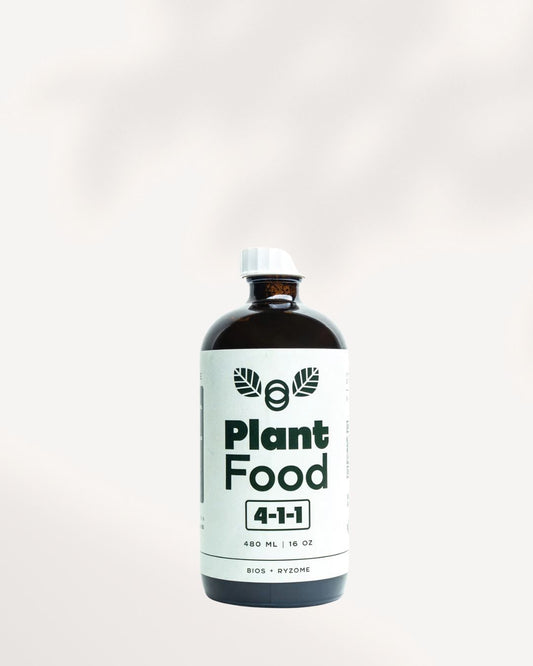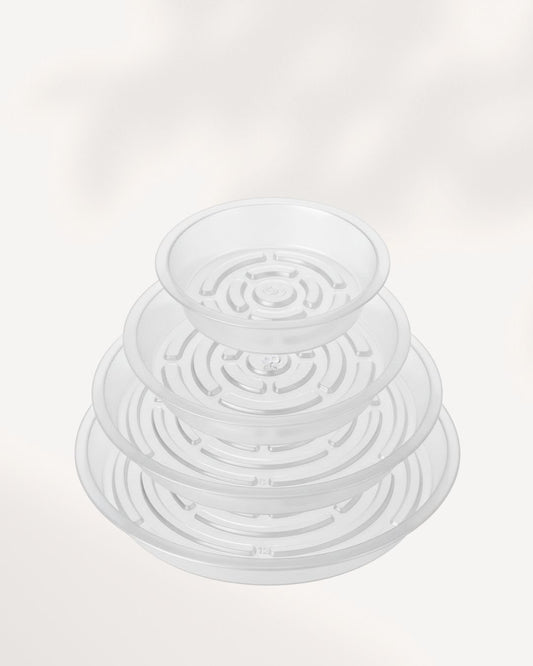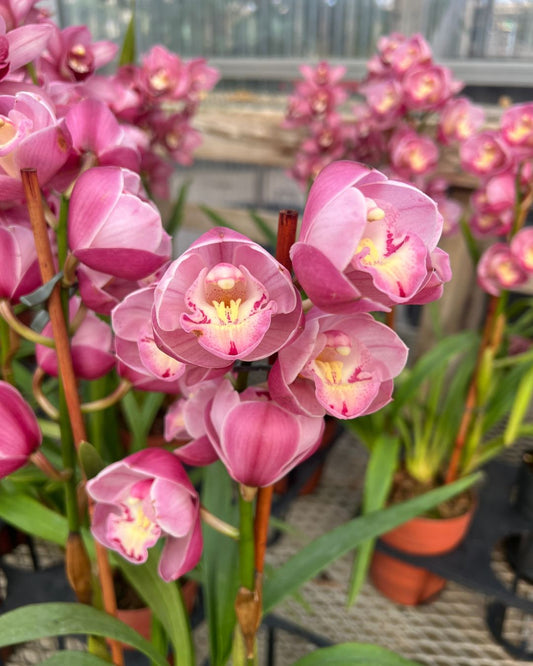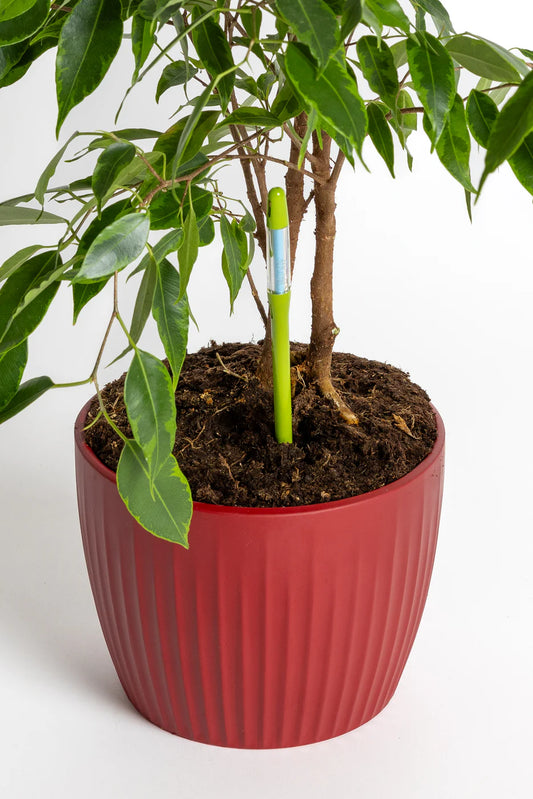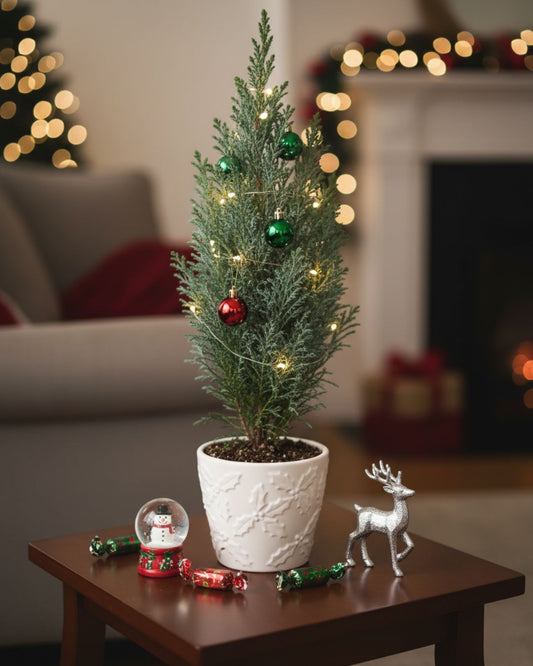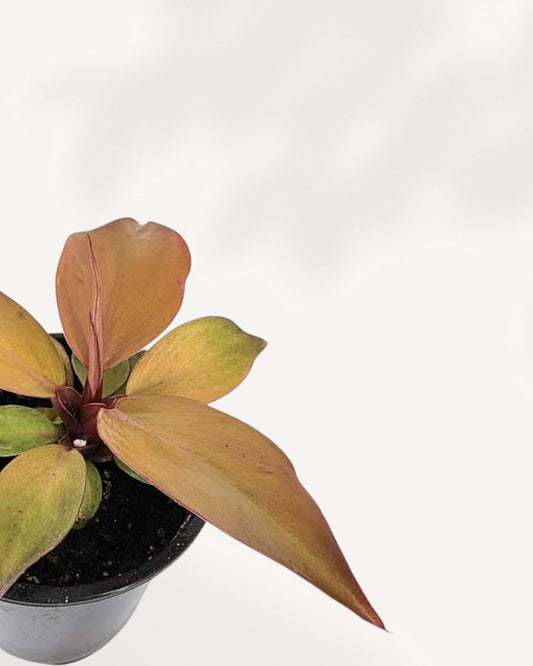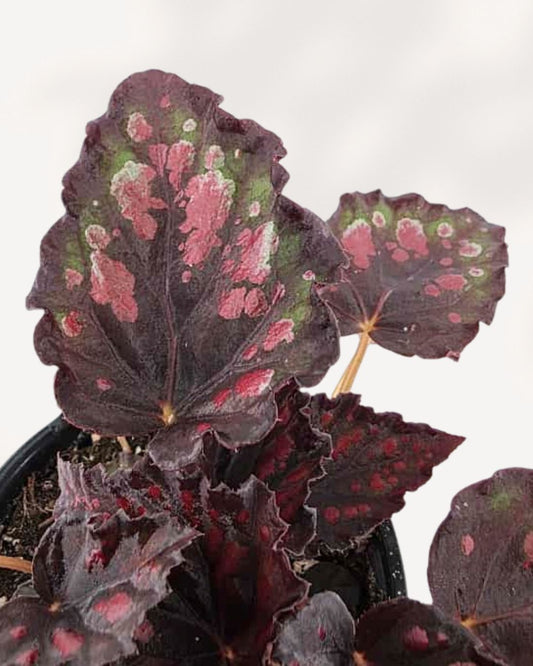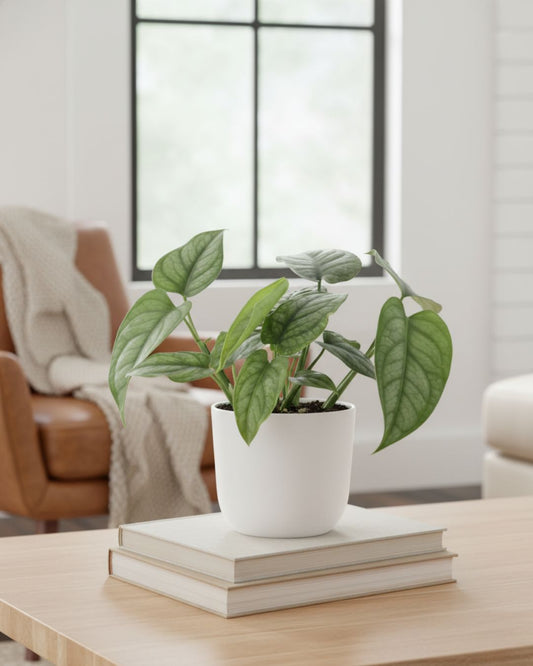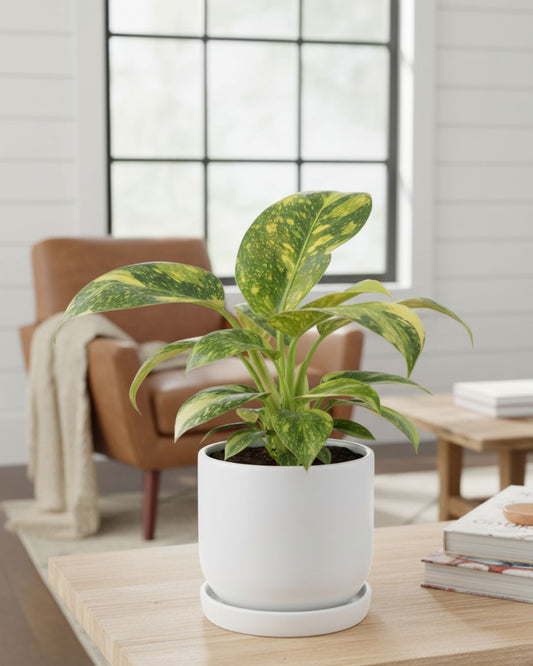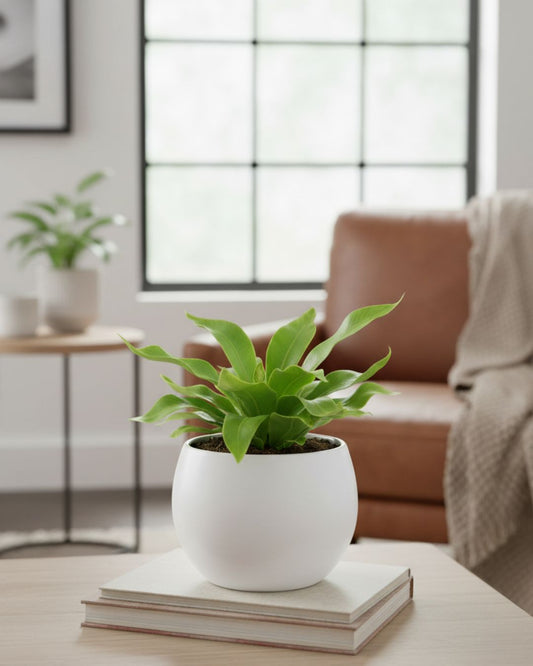Ficus Lyrata Fiddle Leaf Fig Care Guide for Indoor Growers
| Back to Library |
As one of the most popular houseplants, the Fiddle Leaf Fig's care needs are a top search for plant owners. Yet many of those glossy trees still end up with sad brown edges.
The plant is not fussy once its main needs are met: bright, steady light, measured watering, and the right pot mix. Master those basics, and you can stop worrying about sudden leaf drop or yellow patches.
In the guide below, you will find every essential step, arranged in one place, plus practical fixes for the most common problems so you can keep your Ficus lyrata looking photo-ready all year.
Fiddle Leaf Fig Care: A Quick Summary
For those who want answers fast, here is a cheat sheet for a happy Fiddle Leaf Fig.
| Care Aspect | Details |
|---|---|
| Light | 6–8 hours of bright, indirect sunlight daily. An east-facing window is perfect. |
| Water | Water thoroughly when the top 50% of the soil is dry. Let excess water drain out. |
| Soil | A chunky, well-draining mix. Use a blend of bark, perlite, and coco coir, such as our indoor plant potting mix, for optimal drainage and aeration. |
| Humidity | 45–65%. Use a humidifier or pebble tray if your home's air is dry. |
| Temperature | 18°C to 29°C. Avoid cold drafts and temperatures below 12°C. |
| Fertilizer |
Feed with a 3-1-2 liquid fertilizer at half-strength every 4 weeks during spring and summer. |
Fiddle Leaf Fig Care Guide
Below you will find every practical step, light, water, soil, and more, arranged in one place so you can solve problems fast and keep your plant healthy.
1. How Much Light Does a Fiddle Leaf Fig Really Need?
Aim for 6 – 8 hours of bright, indirect light each day. An east-facing window works best because morning sun is gentle yet strong enough to fuel growth. South windows also work if the plant sits at least one metre back or behind a sheer curtain to prevent scorch marks above a bright, indirect light.
If you're unsure about what qualifies as ideal lighting, you can check this guide on understanding plant light requirements for clarity.
Too little light leads to slow growth and oversized gaps between leaves. A simple test: hold your hand 30 cm above the top leaf. If the shadow looks crisp, the light is right. If it is blurry, move the pot closer or add a 20-watt full-spectrum LED grow bar for 12 hours daily.
2. The Right Way to Water Your Fiddle Leaf Fig (And How Often)
Fiddle leaf figs prefer soil that dries halfway before the next watering. Push a wooden chopstick 10 cm deep; if it comes out mostly clean, water thoroughly until 10 – 15 % runs from the base. In summer, this is usually once every 7 – 10 days; in winter, every 14 – 21 days.
Use room-temperature water to avoid shocking the roots and tip out any saucer runoff after 15 minutes. Avoid the “sip” method, which leaves salts behind and encourages root rot.
A moisture meter reading of 4 – 5 (on a 1–10 scale) is the safe zone for the next soak.

3. What's the Best Soil and Pot for This Plant?
Target a pH of 6.0 – 6.5 and a chunky texture. A proven blend is:
- 40 % high-quality peat or coco coir
- 30 % pine bark fines
- 20 % perlite
- 10 % worm compost
The bark keeps structure, the perlite boosts drainage, and the compost supplies gentle nutrients. Repot every 18 – 24 months or when roots circle the base. Choose a container only 5 cm wider than the current one and ensure a drainage hole at least 1.2 cm across to prevent waterlogging.
For optimal root health and drainage balance, try the Connaisseur Indoor Plant Potting Mix designed specifically for container-grown houseplants.
4. What Temperature and Humidity Does It Prefer?
Keep temperatures between 18 °C and 29 °C. A single night below 12 °C may cause leaf drop within a week. Relative humidity should sit at 45 – 65 %. If your room stays below 40 %, place the pot on a pebble tray with 2 cm of water or run a tabletop humidifier set to 50 %.
Monitor with a £10 digital hygrometer; readings help fine-tune misting frequency. Avoid misting in the evening, when wet leaves cool down and invite fungal spots.
Learn more about how excess moisture and cold drafts can trigger fungal issues in our guide on common mistakes in houseplant care.
5. Feeding & Nutrition
During active growth (spring to early autumn), apply a balanced 3-1-2 liquid fertilizer at half-strength every four weeks. This ratio mirrors the nitrogen-heavy composition of healthy fiddle leaves.
Flush the pot every third feed and run tepid water through for 60 seconds to wash out salt buildup that can appear as white crust on the soil surface. Skip feeding entirely from late autumn until daylight lengthens again.
Refer to our indoor plant fertilizer guide for dosage tips and product recommendations.
For more insights on keeping your fiddle leaf fig healthy, check out this Reddit conversation on 'The three rules for a thriving fiddle leaf fig.
The three rules for a thriving fiddle leaf fig
byu/jlesnick infiddleleaffig
How to Prune and Shape Your Fiddle Leaf Fig?
Prune between late spring and midsummer when sap flow is strong. Wear gloves, the latex is mildly irritating. Cut just above a node to encourage branching; limit removal to 10% of foliage in one season.
For height control without lopping the top, pinch the growing tip and tilt the trunk 15 degrees for a month, new shoots will form along the bend. This method is also useful for shaping slower-growing plants, such as the Silver Dollar Plant, which responds well to gradual directional training.
Propagation by air-layering yields a rooted clone in 6 – 8 weeks. Remove a 2 cm ring of bark, dust with rooting hormone, wrap in moist sphagnum and clear plastic, and keep the moss at 70 % humidity until roots fill the wrap, then serve below the new root ball and pot.
How to Choose a Healthy Fiddle Leaf Fig
Your journey to success starts at the plant shop. A healthy plant will adapt to your home much better than a stressed one. Here’s what to look for:
- Firm, Upright Leaves: The leaves should feel sturdy, not floppy. Avoid plants with significant tearing, browning, or yellowing.
- Check for Pests: Inspect the undersides of leaves and the points where leaves meet the stem for signs of webbing (spider mites) or white fluff (mealybugs).
- A Stable Trunk: Give the trunk a gentle wiggle. It should be firm in the soil. A wobbly trunk could indicate a weak root system.
- Signs of New Growth: Look for small, light green buds at the top of the plant, which indicate it's actively growing and healthy.
What's Wrong With My Fiddle Leaf Fig? A Visual Guide to Leaf Issues
Leaves are how your plant communicates. Here’s how to read the signs.
Problem: Brown Patches in the Middle of Leaves, Often with a Yellow Halo.
- Cause: This is typically edema, caused by inconsistent watering. The roots took up water faster than the leaves could transpire it, causing cells to burst.
- Solution: Reduce the volume of water you provide at one time and ensure the plant has adequate light. Stick to a more consistent watering schedule, ideally guided by a soil moisture meter, based on soil dryness.
Problem: Crispy, Dry Brown Edges on Leaves.
- Cause: This is a sign of dehydration, either from underwatering or from low humidity.
- Solution: Check if your soil is becoming bone dry. If not, the cause is almost certainly low humidity. Use a humidifier or a pebble tray.
Problem: Leaves Turning Yellow and Dropping, Starting from the Bottom.
- Cause: This is the classic sign of overwatering and potential root rot.
- Solution: Immediately allow the soil to dry out. If the soil has a sour smell or the problem persists, you must act. Remove the plant, trim away any black, mushy roots, and report in fresh, chunky indoor potting mix to restore airflow and drainage.
Problem: Sudden Mass Leaf Drop.
- Cause: This dramatic reaction is usually due to a sudden change in environment, such as a cold draft or a sudden move to a much darker location.
- Solution: Move the plant back to a stable, warm, and bright location. Be patient; new leaves should appear within a few weeks once it feels secure again.
Pests & Diseases
- Spider mites: look for fine webbing under leaves. Spray with a 2 % horticultural soap every five days for three rounds.
- Scale insects: brown bumps along mid-veins. Dab each with cotton soaked in 70 % isopropyl alcohol, then rinse.
- Mealybugs: white fluff in crevices. Remove with a soft brush and apply neem oil at 7-day intervals until clear.
- Fungal leaf spot thrives above 75 % humidity with poor air flow. Trim damaged foliage, space plants 30 cm apart, and run a small fan for two hours daily.
Common Fiddle Leaf Fig Myths Debunked
There's a lot of advice out there, but not all of it is helpful.
Myth 1: Misting is a good way to raise humidity.
Reality: Misting only provides a fleeting moment of moisture and does little to change the ambient humidity. Worse, letting water sit on the leaves overnight can invite fungal diseases. A humidifier is a far more effective solution.
Myth 2: Fiddle Leaf Figs hate all direct sun.
Reality: While they can scorch in harsh, direct midday sun, they love gentle morning sun. An hour or two of direct morning light from an east-facing window is highly beneficial.
Myth 3: You should put it in a big pot so it has room to grow.
Reality: A pot that is too large holds excess soil that stays wet for too long, leading directly to root rot. Only increase the pot size by about 5 cm at a time.
Conclusion
Bright, steady light, measured watering, and a breathable potting mix give your fiddle leaf fig a reliable foundation. Fine-tune humidity, feed modestly, and prune with care to shape a compact tree. When trouble strikes, use the checklist above to read the leaves and act quickly.
Discover Our Ficus Plant Collection 🌿
Explore a variety of stunning ficus plants that will bring greenery to your space!
Explore NowFrequently Asked Questions
How do you care for a Ficus lyrata indoors?
Provide bright filtered light, water when the top half of the soil dries, use a chunky mix, keep humidity around 50 %, and feed monthly in spring and summer.
How often do you water a Ficus lyrata plant?
Roughly every 7 – 10 days in warm months and 14 – 21 days in cooler periods, always guided by soil dryness rather than the calendar.
Why are the leaves on my fiddle leaf fig falling off?
Common triggers are low light, cold drafts, root rot, or a recent move. Correct the environment first; new growth signals recovery.
What not to do with a fiddle leaf fig?
Do not leave it in standing water, expose it to direct midday sun without acclimation, or shift it between light extremes in a single day.
The Positive Impact of Plants
-
Plants and Healing
Working with plants soothes the mind. It feels calming and healing, offering a peaceful break from daily life.
-
Plants for Recovery
Being around plants can speed up healing from sickness, making you feel better quicker in a natural way.
-
Plants and Work
Plants in your space may make your work better and faster, enhancing focus and creativity during tasks.
LETTING CUSTOMERS SPEAK FOR US!
Shop by Feature
FAQs for Plant Delivery in Ontario & Quebec
What types of house plants do you offer for delivery.
We offer a wide variety of houseplants for delivery. Here are some of the popular options: Aglaonema, Alocasia, Calathea, Hoya, Monstera, Palm, Peperomia, Philodendron, Pothos, Sansevieria Snake, Syngonium, Tradescantia.
What is the lifetime support?
All plants purchased from our store or through our workshops come with lifetime support. This means that whenever you have questions or concerns about your plant, we're here to help. Whether you're unsure about your plant's health or need advice, we can assist in identifying problems, answering your questions, and potentially saving your plant. Feel free to reach out to us on Instagram @mygreenscapeto or via email at support@mygreenscape.ca.
Where do Mygreenscape plants come from?
Our plants embark on a journey from various greenhouses across Canada. We prioritize short delivery routes to ensure your plant arrives happy, healthy, and full of vitality.
Do I have to repot my plants once they arrive?
Absolutely not! When your plant arrives, give it time to settle into its new home. Place it in the desired spot, and let it acclimate for about two weeks.
Favorite in our plant shop
-
Liquid Plant Fertilizer
Regular price From $30Regular priceUnit price per -
Plant Saucer
Regular price From $2Regular priceUnit price per -
Cymbidium Orchid
Regular price $89Regular priceUnit price per -
SUStee Soil Moisture Indicators
Regular price From $12Regular priceUnit price per -
Christmas Cactus
Regular price $12Regular priceUnit price per -
Ellwoodii Cypress
Regular price $18Regular priceUnit price per -
Philodendron 'McColley's Finale'
Regular price $15Regular priceUnit price per -
Begonia Rex 'Harmony Stained Glass'
Regular price $15Regular priceUnit price per -
Monstera Siltepecana
Regular price $15Regular priceUnit price per -
Philodendron Green Congo Nuclear
Regular price $45Regular priceUnit price per -
Nepenthes Sanguinea Pitcher Plant
Regular price $35Regular priceUnit price per -
Cobra Fern
Regular price $18Regular priceUnit price per
MyGreenScape is your go-to online shop for indoor plants in cities Ontario or Quebec, including Toronto, Montreal, and many more. Our mission is to add joy to your home, one leaf at a time. Explore our range of beautiful, air-cleaning plants from the comfort of your home. You can find beautiful indoor plants, pots for plants, garden tools, and hanging basket plants all in one spot. Our mission is to add joy to your home, one leaf at a time.
Buying plants online with us means no more carrying heavy pots or figuring out how to get big plants home. We deliver straight from the gardener to you, with eco-friendly packaging, across Ontario and Quebec. Expect your new green friends within 2-7 days.
Why choose MyGreenScape? Here’s why:
- Lifetime Support: We’re here for you always. Get all the help you need for your plants to flourish.
- 30-Day Happy Plant Guarantee: Not happy with your plant? Tell us within 30 days, and we’ll fix it.
- Easy Delivery: Fast, direct to your doorstep in Ontario or Quebec.
Hear from a happy customer, Sarah T.: "Buying plants was never easier. Quick, simple, and with great support from MyGreenscape."
Ready for easy, stress-free plant shopping? Visit us now and make your home greener. Join MyGreenScape for a hassle-free way to bring nature inside.



















